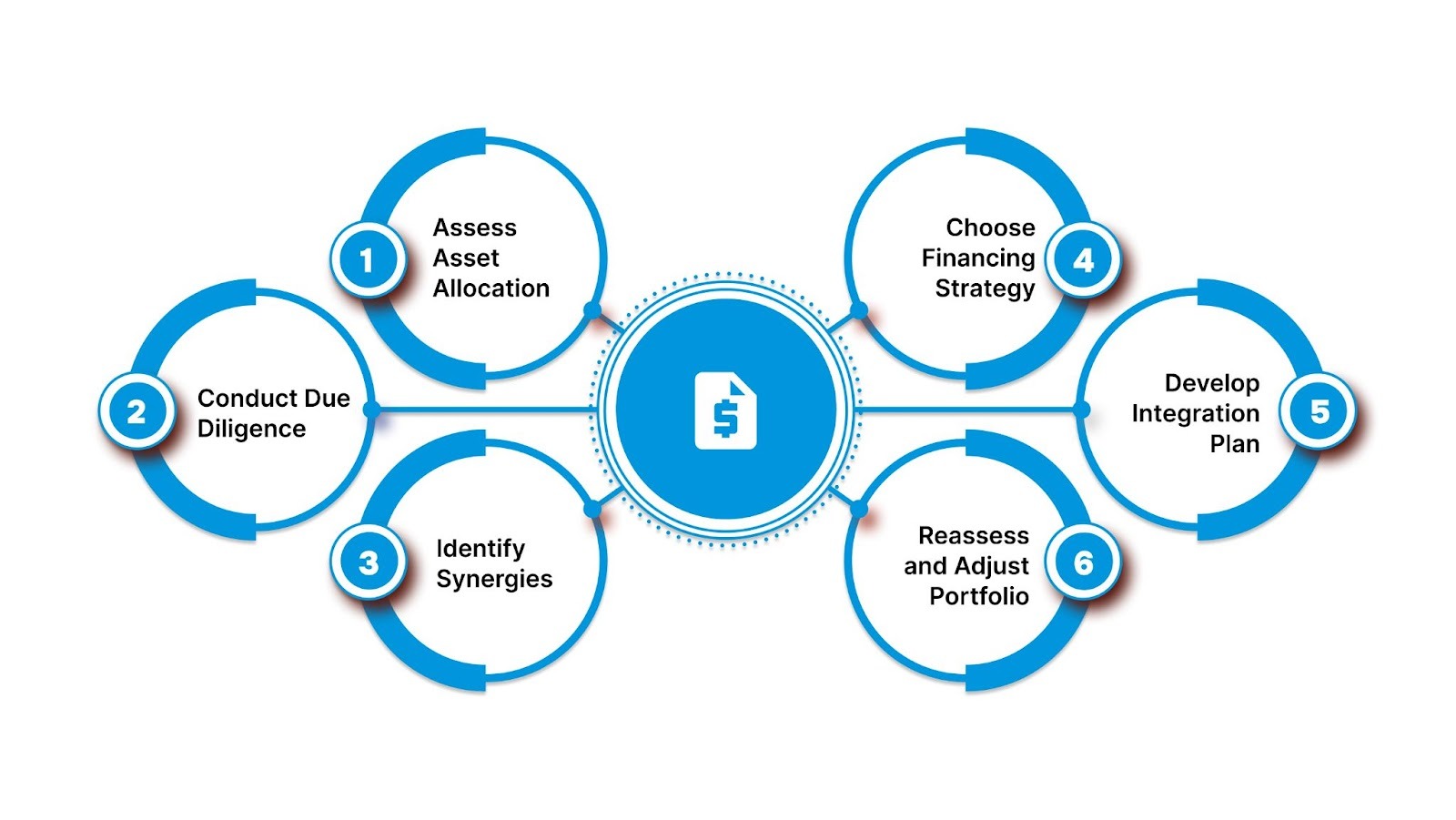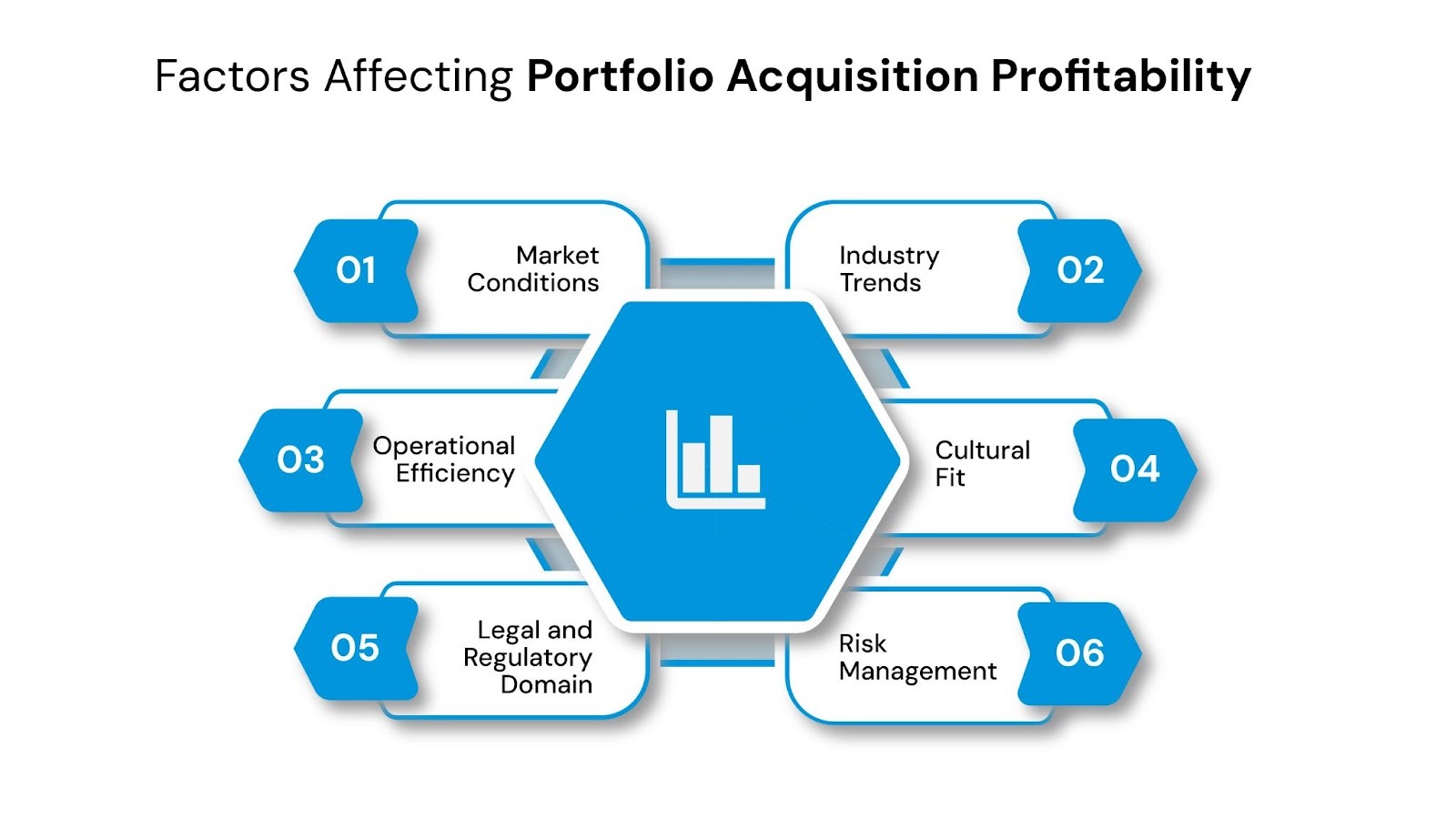Steps to Economically Profitable Portfolio Acquisitions
Steps to Economically Profitable Portfolio Acquisitions

Transform Your Financial Future
Contact UsIn the current volatile market, portfolio acquisitions are a high-stakes game. As a CFO or business leader in sectors like technology, healthcare, or finance, you know that making the wrong move can have costly consequences.
With the market shifting constantly, the pressure to secure the right assets is stronger than ever. Despite volatility, strategic portfolio acquisitions are accelerating in these industries, as companies look to strengthen their portfolios and explore new growth opportunities.
This blog will guide you through the critical steps to ensure your portfolio acquisitions are not only economically profitable but also future-proof. We’ll also learn how to fine-tune strategies and make informed decisions that deliver long-term returns.
Key Takeaways
- Strategic Planning is Key: Set clear financial and strategic objectives to ensure your portfolio acquisitions align with long-term goals and market positioning.
- Due Diligence is Critical: Thoroughly assess the financial stability, market position, and risks of potential assets to ensure they contribute to sustainable profitability.
- Identify Synergies for Growth: Look for opportunities to create value beyond the asset itself, through cost reductions, new revenue streams, or expanding market reach.
- Choose the Right Financing Strategy: Balance equity and debt financing to manage risk while supporting growth, depending on your long-term business needs.
- Integration and Monitoring Matter: Plan early for seamless integration and continuously evaluate your acquisitions to ensure they align with evolving market conditions and business objectives.
What are Portfolio Acquisitions?
Portfolio acquisitions involve purchasing a collection of assets, often from a different company, to enhance a business's value or capabilities. This strategy enables companies to diversify and grow by acquiring not only individual assets but also entire portfolios, such as stocks, bonds, or entire business units.
These acquisitions are a way to build long-term value, improve market positioning, and utilize synergies between the acquired assets and existing operations.
Also Read: Portfolio Management Steps and First Step Explained
Now that we understand what portfolio acquisitions are, let’s explore the key steps involved in making economically profitable portfolio acquisitions.
Key Steps to Economically Profitable Portfolio Acquisitions

Achieving profitable portfolio acquisitions requires a strategic approach that maximizes returns and minimizes risks. Here are the essential steps to ensure success:
1. Determine Your Appropriate Asset Allocation
Start by assessing your financial situation, goals, and risk tolerance. Factors like your age, time horizon, income needs, and personality influence how your investments should be allocated.
Younger investors may take on more risk, while those closer to retirement should prioritize asset protection. Understanding your unique situation is crucial to creating a portfolio that meets both your immediate and future needs.
2. Conduct Thorough Due Diligence
Due diligence is crucial in any acquisition. Evaluate each potential asset for financial stability, growth potential, and strategic fit. This involves assessing financials, market position, and risks, while ensuring the asset aligns with the company's long-term business objectives.
3. Identify Synergies for Long-Term Value
Look for opportunities where the acquisition can create value beyond asset accumulation, such as through operational efficiencies or new revenue streams. Synergies might also include cross-selling, expanding into new markets, or improving overall product offerings.
4. Choose the Right Financing Strategy
Financing your acquisition correctly is essential for ensuring profitability. Consider whether equity, debt, or a combination of both will best serve your business. The strategy should strike a balance between financial risk and growth potential, taking into account your long-term goals and the stability of your cash flow.
5. Develop a Clear Integration Plan
Develop a plan for merging operations, technologies, and leadership. Clear communication and a streamlined process will help integrate the new asset seamlessly into your existing portfolio, enabling you to realize synergies and avoid disruptions.
6. Reassess and Adjust Your Portfolio Regularly
Periodically review whether your asset allocation remains aligned with your financial objectives. Rebalancing when necessary ensures that your acquisitions continue to work in your favor, optimizing both growth and risk.
Following these key steps ensures that your portfolio acquisitions remain profitable and sustainable for the long term.
Achieving economically profitable portfolio acquisitions requires a strategic approach, and at The Forest Hill Management, we’re here to help you every step of the way.
Our personalized financial advisory services can guide you through these key steps, from assessing your financial situation to choosing the right financing strategy. Contact our financial advisors to create a custom plan that aligns with your goals and sets you up for long-term success.
With the key steps in mind, let’s look at the factors that can influence the profitability of these acquisitions and how to manage them effectively.
Factors Impacting the Profitability of Portfolio Acquisitions

The profitability of portfolio acquisitions is influenced by a range of factors that businesses must carefully consider to maximize returns and minimize risks.
- Market Conditions: Economic shifts, interest rates, and market volatility can all impact the performance of acquired assets. Staying informed about broader market trends is crucial to making wise acquisitions.
- Industry Trends: Acquiring portfolios in industries with strong growth potential can boost profitability. Industries such as technology, healthcare, and finance are ripe with opportunities but can also be highly competitive.
- Operational Efficiency: The ability to integrate new assets efficiently into your existing operations plays a key role in profitability.
- Cultural Fit: The success of an acquisition often hinges on the compatibility between organizations. A poor cultural fit can lead to disruptions, impacting overall profitability and growth.
- Legal and Regulatory Domain: Understanding the legal and regulatory requirements in both the acquisition process and post-acquisition operations is vital.
- Risk Management: Effectively identifying, assessing, and mitigating risks ensures that acquisitions add value. Without solid risk management, even the most promising acquisitions can turn unprofitable.
Carefully considering these factors helps businesses tackle the complexities of portfolio acquisitions and achieve sustained, long-term profitability.
Also Read: Credit Portfolio Management: Ultimate Guide and Strategies
Now that you know how to approach profitable acquisitions, let's see how The Forest Hill Management can help you take control of your financial journey.
How The Forest Hill Management Can Help You Achieve Financial Control
At The Forest Hill Management, we understand that dealing with financial stress can be overwhelming. We’re here to support you every step of the way, whether you're facing high debt loads, struggling with poor credit, or worried about wage garnishment.
Our services are designed with your needs in mind:
- Secure Online Payment Platform: Easily manage your payments and stay on top of your financial commitments with our secure, user-friendly platform.
- Personalized Financial Advisory Services: Get tailored advice from experts who understand your unique situation and are dedicated to helping you regain financial control.
- Flexible Repayment Options: We offer customizable repayment plans tailored to your budget, allowing you to move forward with confidence.
- Guidance Through Wage Garnishment: If you're facing wage garnishment, we can help you explore your options and take proactive steps to protect your income.
Take the first step toward regaining financial control today and contact our financial advisors to create a custom plan that works for you.
Conclusion
In the current complex market conditions, strategically acquiring portfolios can position your business up for long-term success, but it requires careful planning and execution. Remember, the right approach to portfolio acquisitions drives profitability and strengthens your position in the market, ensuring sustained growth.
Applying these strategies ensures you’re equipped to make informed decisions that align with your business goals and drive profitability and growth.
Take the first step toward securing a profitable future. Contact our financial advisors today to create a custom plan tailored to your acquisition strategy.
FAQs
1. What makes a portfolio acquisition profitable?
A profitable portfolio acquisition involves selecting assets that align with your long-term goals, offer growth potential, and integrate seamlessly with your existing operations.
2. Why is due diligence so important in portfolio acquisitions?
Due diligence helps you understand the financial health, risks, and market position of the assets you’re acquiring, ensuring they’re a good fit for your business.
3. How do I choose the right financing strategy for an acquisition?
The right financing strategy strikes a balance between equity and debt, tailored to your risk tolerance, financial stability, and growth objectives. It’s key to choosing a path that supports long-term profitability.
4. How do I identify synergies in an acquisition?
Look for areas where the acquisition can add value beyond just the asset itself, such as operational efficiencies, new revenue streams, or opportunities to expand into new markets.
5. How often should I reassess my portfolio acquisitions?
It’s essential to evaluate your asset allocation and make adjustments as needed periodically. This ensures your acquisitions remain aligned with your evolving financial objectives and market conditions.
-p-500%20(1).png)